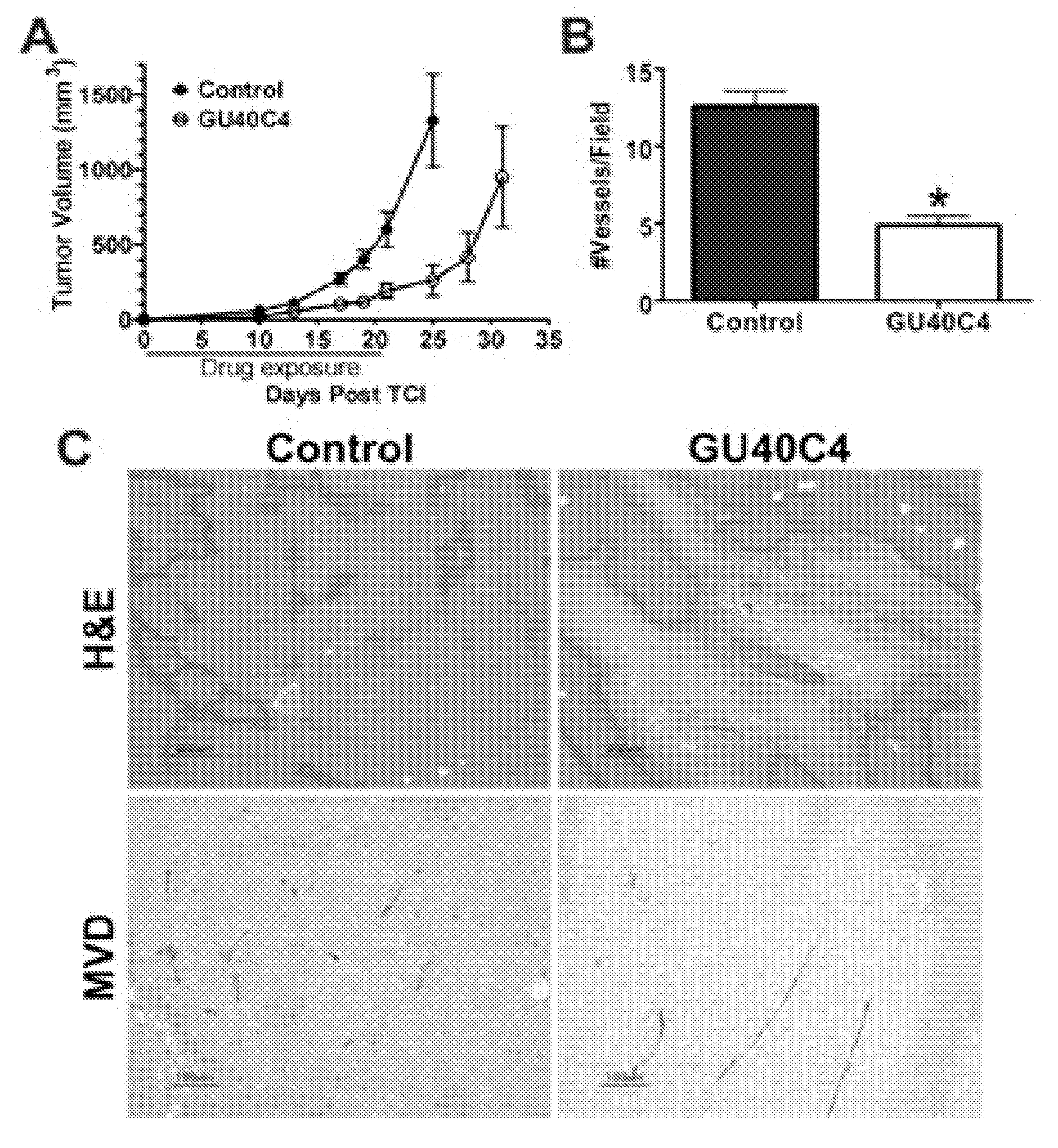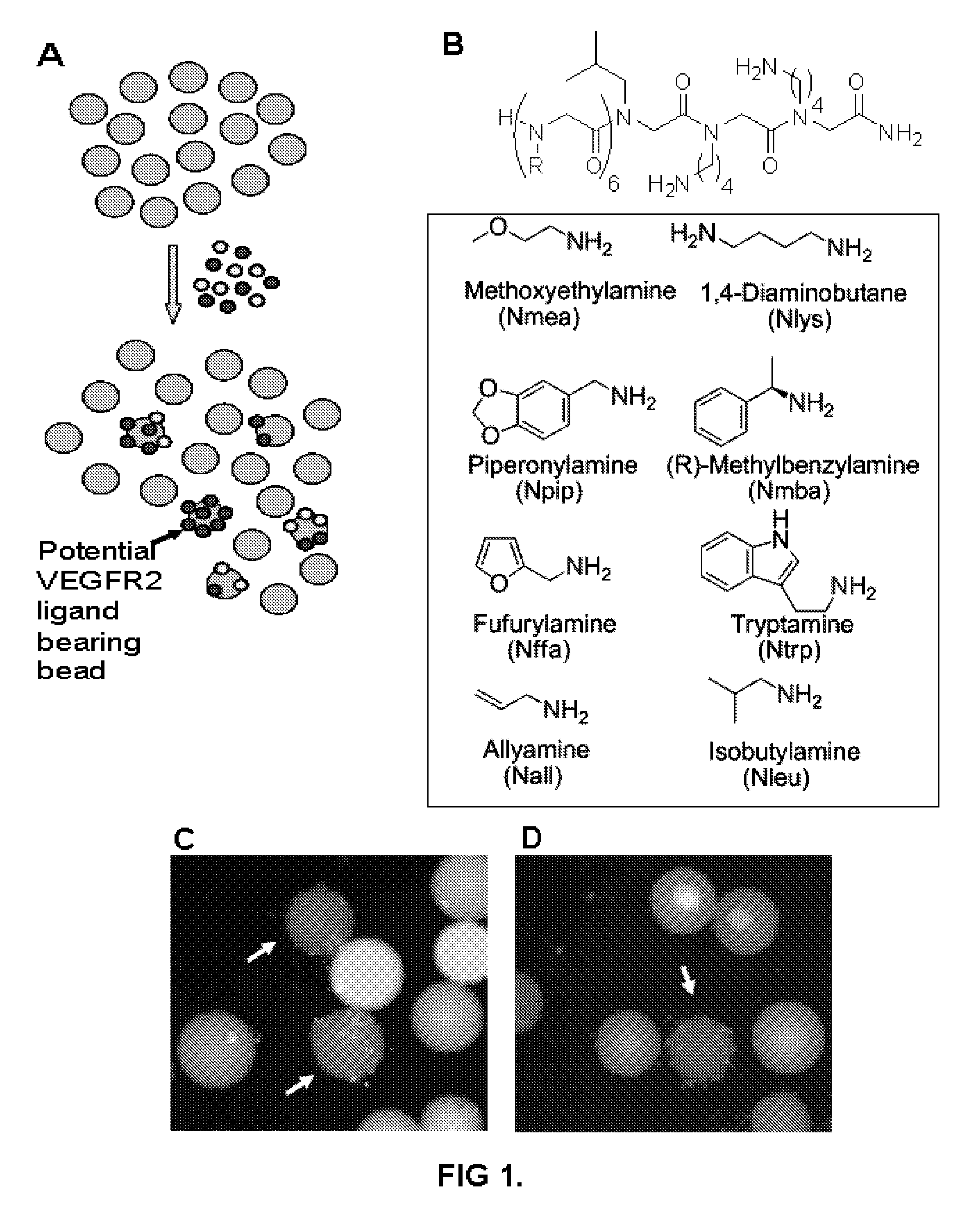High affinity vegf-receptor antagonists
a vegf receptor and high affinity technology, applied in the field of peptide and peptoid chemistry, molecular biology and cell biology, can solve the problems of high cost, large quantity, and difficult to isolate small molecule antagonists of protein-protein interactions, and achieve high specificity for the target receptor
- Summary
- Abstract
- Description
- Claims
- Application Information
AI Technical Summary
Benefits of technology
Problems solved by technology
Method used
Image
Examples
example 1
A. Materials and Methods
[0161]Peptoid library synthesis. 9-mer peptoid library was synthesized on TentaGel macrobeads (140-170 μm; substitution: 0.48 mM / g resin; Rapp Polymere) using microwave (1000 W) assisted synthesis protocol. TentaGel macrobeads were distributed equally into eight peptide synthesis reaction vessels, swelled in dimethylformamide (DMF) and each reaction vessel was treated with 2M Bromoacetic acid and 3.2M Di-isopropylcarbodiimide (DIC) and the coupling was performed in microwave oven set to deliver 10% power (2×15 seconds). After washing the beads with DMF, each vessel was treated with one of the eight primary amines at 2M concentration and again the coupling was performed in microwave as described above. Beads were washed, pooled, randomized and were redistributed equally into eight peptide synthesis vessels, and the procedure was repeated until the desired length is achieved. For first three fixed residues (Nleu-Nlys-Nlys), each step was followed as above excep...
example 4
[0197]Rapid identification of the ‘minimum pharmacophore’ of a lead compound is a vital step in the drug development process since it sets the stage for subsequent optimization. With peptide-based agents, this exercise is simplified by the regular structure of the molecule. A common practice is to evaluate a series of derivatives in which each residue in turn is replaced with a glycine or alanine (alanine scanning) (El Kasmi et al., 1998; Slon-Usakiewicz et al., 1997). Recently, the inventors reported the effective application of glycine scanning to a peptoid (N-substituted oligoglycine) inhibitor of the 19S regulatory particle of the proteasome. This allowed the inventors to create a minimal derivative of the original hit with about half the mass and thus increased cell permeability and potency (Lim et al., 2008). They have also reported the isolation of highly specific peptoid ligands for the extracellular domain of the Vascular Endothelial Growth Factor Receptor-2 (VEGFR2) (Uduga...
example 5
[0206]The inventor sought to develop a rapid and sensitivity screen for agents that bind to pre-selected cell surface structures in a specific fashion. This assays was initially developed using cells expressing the VEGF-2 receptor. Receptor-expressing cells or receptor-null cells were mixed in an approximately 1:1 ratio. The cells were then exposed to a library of molecules displayed on hydrophilic beads (FIG. 23) and after appropriate incubation and washing, the beads that bind only one color cell (red) were picked. The beads were boiled in SDS to remove the cells and other debris and the molecules bound are identified by automated Edman degradation.
[0207]This two-color assay demands extremely high specificity, as if the bead-displayed molecule binds any other molecule on the cell surface other than the target receptor, then both colored cells will be retained and the molecule will not be identified as a hit. As evidence of this, the inventors obtained only 5 hits out of 300,000 co...
PUM
| Property | Measurement | Unit |
|---|---|---|
| volume | aaaaa | aaaaa |
| pH | aaaaa | aaaaa |
| dissociation constants | aaaaa | aaaaa |
Abstract
Description
Claims
Application Information
 Login to View More
Login to View More - R&D
- Intellectual Property
- Life Sciences
- Materials
- Tech Scout
- Unparalleled Data Quality
- Higher Quality Content
- 60% Fewer Hallucinations
Browse by: Latest US Patents, China's latest patents, Technical Efficacy Thesaurus, Application Domain, Technology Topic, Popular Technical Reports.
© 2025 PatSnap. All rights reserved.Legal|Privacy policy|Modern Slavery Act Transparency Statement|Sitemap|About US| Contact US: help@patsnap.com



